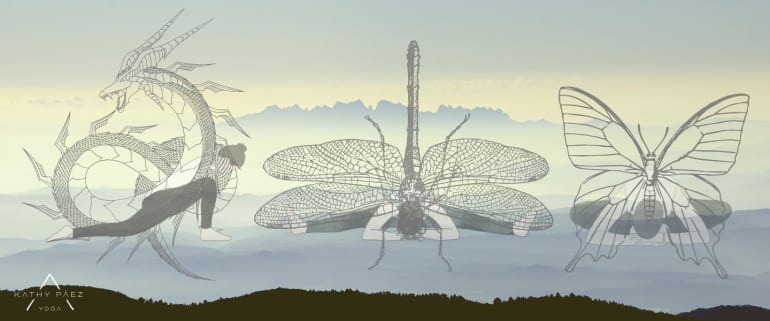Dragons, dragonflies and butterflies welcome you to the world of Yin Yoga. […]
One of the things that first surprised me about yin yoga when I first started practicing it, sensorial depth experience aside, were the names of the poses. They were so different from the names I already knew. I learned over time that the same thing happens in any Haṭha Yoga with different lineages from India, in Sanskrit. For example, Baba Hari Dass of Mount Madonna Center calls śavāsana (corpse pose) by the name of, paryaṅkāsana (lying on the lap of mother earth). In yin yoga my teachers, sometimes refer to śavāsana as pentacle. I refer to this posture as star or star looking at the sky. The names of the postures we use in yin yoga are original to this practice, not a Sanskrit translation (example below).
A little history of Yin Yoga
When the yin yoga practice began in the late 80s, most yogis in the USA were practicing aṣṭāṅga vinyāsa yoga and Iyengar yoga. Paul Grilley, the founder of yin yoga, started teaching the yin yoga poses under different names, with the aim of inspiring a quiet and internal practice. Their names were influenced by Taoism, another important part of the history of this practice. However, they are Haṭha Yoga poses, and you could use the Sanskrit names if you wanted.
When studying with Paul and Suzee Grilley you learn that the most important thing is the objective of your practice and each pose. The names of the positions are simply references to remember and communicate.
For the curious, an example of Sanskrit transliteration:

बद्धकोणासन
ब Ba, द्ध ddha, को ko, णा ṇā, स sa, न na
Baddha koṇāsana
Baddha + koṇa + āsana
Baddha = bound, koṇa = angle, āsana = seat/pose
Bound angle pose would be its translation or rather transliteration. Transliteration in this case comes from the Devanāgarī, scripture in Sanskrit. Each sound of the Sanskrit alphabet is translated into the IAST (International Alphabet Sanskrit Transliteration) allowing the romanization of Indian writing without loss of information. Thus we can pronounce it without having to know the alphabet in Sanskrit (Devanāgarī). In the Haṭhayogapradīpikā, 1. 54 (Svatarma, around the 15th century) refers to this posture as bhadrāsana(noble posture). In Makaranda Yoga (Sri T Krishnamacharya, 1934) it refers to the posture as Baddha koṇāsana (bound angle posture). In yin yoga we refer to it as the butterfly posture.
Disclaimer: I do not claim to be an expert in Sanskrit with this text. Sanskrit is a hobby that I have been able to study under Dr. Maria Elena Sierra at the University of Barcelon. I just wanted to share some insights to consider when thinking about the names of the postures, be it in Yin or any style of Yoga.



